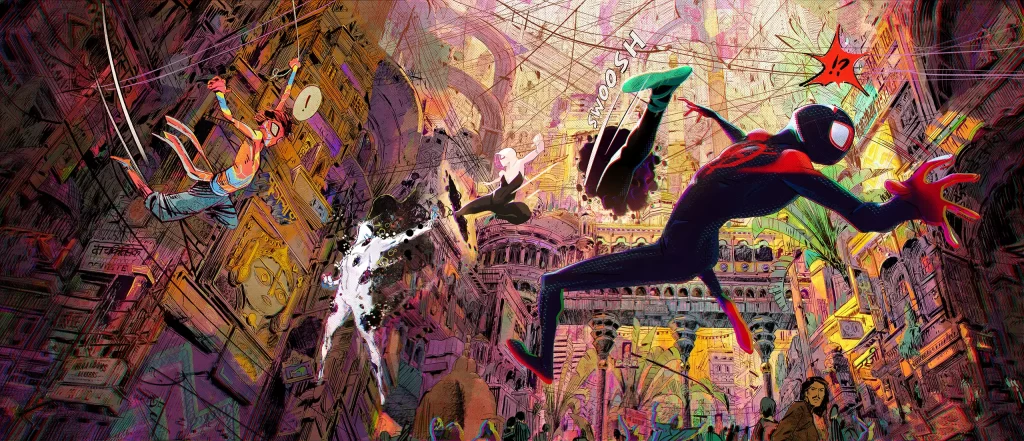Alright, let’s do this one more time.
If you haven’t seen Spider-Man: Across the Spider-Verse yet, which, after two months of its release, is absolutely a crime- GO WATCH IT right away! I’ll try to keep this review as spoiler-free as possible. And if you are skeptical about whether you’ll get it since you don’t keep up with superhero movies, you only need to watch the first part to catch up with the lore. So, now that we’ve got that out of the way, let’s start the review.
I’ll be honest, I’ve never read the comics and the last I kept up with the MCU was until Endgame, but I think Across the Spider-Verse might just be the best film of all time. Watching the movie in theaters three times only reinforced that belief with each watch.

Spider-Man: Across the Spider-Verse is a visual feast. With its extraordinary display of combining more art styles than probably should be allowed and an amazing musical score by Daniel Pemberton, the film does not have a single boring moment. There is so much happening all the time, but it never gets chaotic. It addresses what needs to be addressed and creates a cohesive canvas filled with explosive colors, explosive emotions, and eclectic styles.
The hue of each scene represents the mental and emotional complexity of the life of each Spiderman and their own universe. The colors change as swiftly as the mood of the scene, which is abrupt and often very relatable.
Spider-Man has been around since 1962. We have seen many renditions of the same story of a boy named Peter getting bitten by a radioactive spider and getting stuck with super-strength and maintaining two different identities. You had to come up with something incredible to be memorable. And Spider-Man: Across the Spider-Verse did it perfectly. The inclusion of the Spider-Verse is only a small part of it.

There are a few primary characteristics that make Spider-Man who he is. He is a super-smart teenager who is torn between juggling his studies, typical teenage angst, love life, and high-school drama, all the while hiding his identity of being a crime-fighting vigilante.
The name that we associate with Spiderman is Peter Parker. In every universe, Spider-Man is some version of Peter Parker. Sometimes it’s a pig called Peter Porker, sometimes it’s a car called Peter Parkedcar. But this time it is the story of Miles Morales, not Peter Parker. And that is the box that unravels all the adventure that ensues.
Miles Morales was introduced as a legacy character in the comics. The idea of An Afro-Latino Spiderman was hard to digest for many so he never became a full-fledged Spiderman.
With the Spider-Verse franchise, Sony is pushing these horizons and making sure inclusion and other modern ideas are visible to the audience. This is a bold and appreciated move, especially when the opposition against minorities and less-represented societies seems to be at an alarming high. A lot of discourse surrounded when Marvel introduced Zendaya, a biracial brown-haired woman, as MJ. People were severely upset over it and even started a hate train with hashtags #NotMyMJ even though they were supposed to be different characters.
Fortunately for Spider-Verse, that level of hate has not been seen. It is a widely acclaimed feat of animation. However, the creators of Spider-Man have taken that discourse as inspiration.

I loved how the film incorporated very real concerns parents have as their children grow up. Spider-Man, while being a superhero, is still very much a teenager. His struggles as a teenager about who he is, where he belongs, and if he can create a place for himself in this world take up a prominent space in his life.
The movie did an amazing job of portraying parents who want to be supportive, yet they are still skeptical about their child’s well-being because of how secretive he is. It is a very real concern that every parent faces.
Miles loves his parents more than anything but his relationship with his parents bears the brunt of him becoming Spiderman. He is often misunderstood as he feels like he can’t communicate with them keeping such a big part of his identity hidden. Being Spider-Man comes with its own set of problems. He misses classes, he’s late to parties. It doesn’t help with the kind of helicopter parenting Jeff and Rio do. They tighten their hold as a solution, but since he is Spiderman, he can’t succumb to that, making it even rockier.
The only people that can relate to this life are other Spider-Men which is why he wants to meet them again so desperately.
He wants to go as far as studying quantum physics far away in New Jersey to work on inventing something that will let him go to other dimensions to meet his friends.

What makes Spider-Verse so hugely successful?
Many films before this have tinkered with the idea of a Multiverse. We have seen it in Marvel movies like Doctor Strange Multiverse of Madness, and Spider-Man: No way Home. But there was a lack of creativity in the execution. Multiverse opens the door to so many possibilities. There are infinite ways, obnoxious, exaggerated, wild ways to make use of it. The sky’s the limit. It is more than just using another actor as Captain America, using different color palettes for the world, or putting as many cameos as possible in a film.
The best portrayal of Multiverse that I have yet to date is Everything Everywhere All at Once, another film I’d highly recommend. It has parallel universes where random things happen like having hotdogs for fingers or even universes where you are a rock because Earth’s conditions were too adverse for lifeforms to exist (how cool is the ideation!). It rightfully claimed its Oscar for best visual effects because of that one scene. You’d know if you have seen it. Yes, I’m gatekeeping it (Watch it now)!
The secret behind the success of Spider-Verse lies behind the formula of the astonishing success of EEAO.
That single spider-chase scene showed us more versions of Spider-Man than we could have come up with in our wildest imaginations. Each of them had a unique art style and a separate backstory that connected smoothly. It got chaotic but never incoherent.
The film was a 2-hour 16 minutes of adrenaline rush that only got better every second. And it’s only fitting as Spider-Man: Across the Spider-Verse has a scene that nods to the EEAO as well.

Spider-Verse not only incorporates every version of Spider-Man that you could think of, but it also has a separate art style for each human Spiderman based on their personality and origin.
Miles World is a 3D realistic CGI inspired graffiti style art. Gwen’s world, on the other hand, is a dreamy pastel watercolor-based world. Moreover, her world shifts and twists its colors based on her emotions from closing in on herself.
The scene where she argues with her father as colors start dripping from the walls and getting darker, somber, and more melancholy, is one of my absolute favorites.
A lot of the credit for this brilliant execution of Spider-Verse goes to Sony. When they get the freedom, they go all out in terms of creativity, theatrics, and amazing storytelling. However, this also comes with its cons.
As many as 100 artists had to quit because of the terrible working conditions and unrealistic deadlines. Sony is on the right track in terms of storytelling and representation by including a diverse workforce in their set, but they need to maintain proper working conditions for their artists.
We cannot talk about this film without talking about its amazing soundtrack. Produced by Metro Boomin, the soundtrack is a perfect culmination of theme and musical artistry. The songs go well with the scene that is being played out in front of us. While some songs falter from the theme as the singers take artistic liberties, a song that perfectly blends with the film and is stellar by itself is James Blake’s Hummingbird. However, personally, my favorite from this album has to be ASAP Rocky’s “Am I Dreaming”.
There are many big names in the industry, like Oscar Isaac, Shameik Moore, Daniel Kaluyya, and Hailee Steinfeld, who are voice-acting in the film. There have been many internet discourses on why it’s not a good idea to cast famous actors for voice acting. Being a good actor doesn’t automatically mean they would be good at voice acting. Some unimpressive voice acting examples would be Chris Pratt’s Mario or Tom Holland in Onward.
Yet in this film, the actors accurately managed to capture the right cadence and emotions of every Spiderman. Miles sounded like a 15-year-old and Peter B. Parker like an exhausted dad. Their voice work made them indistinguishable from the characters.
The big names don’t take away from the story at all. Rather, it’s the story that makes the actors.

Action-packed, visually pleasing, raw emotional appeal, jaw-dropping twists, and excruciating cliffhangers. It is not only one of the best-animated films of all time; it is not far-fetched to say that this film is one of the best films ever, period. It will keep you on the edge of your seat the whole time.
Every frame is a painting. It really seemed like every frame was intentional, well thought out, and created with a lot of care. You may have already seen that a specific chase scene alone would have taken an artist four years to complete. But it was worth the wait. You might have to remember that always because, boy, oh boy, you will have to wait for the next rendition of Spider-Verse. This is not going to be like waiting for just any other movie. Once you reach the movie’s end, you will realize the wait is about to be excruciating. Why? Well, that’s the cliffhanger I am leaving you with!






